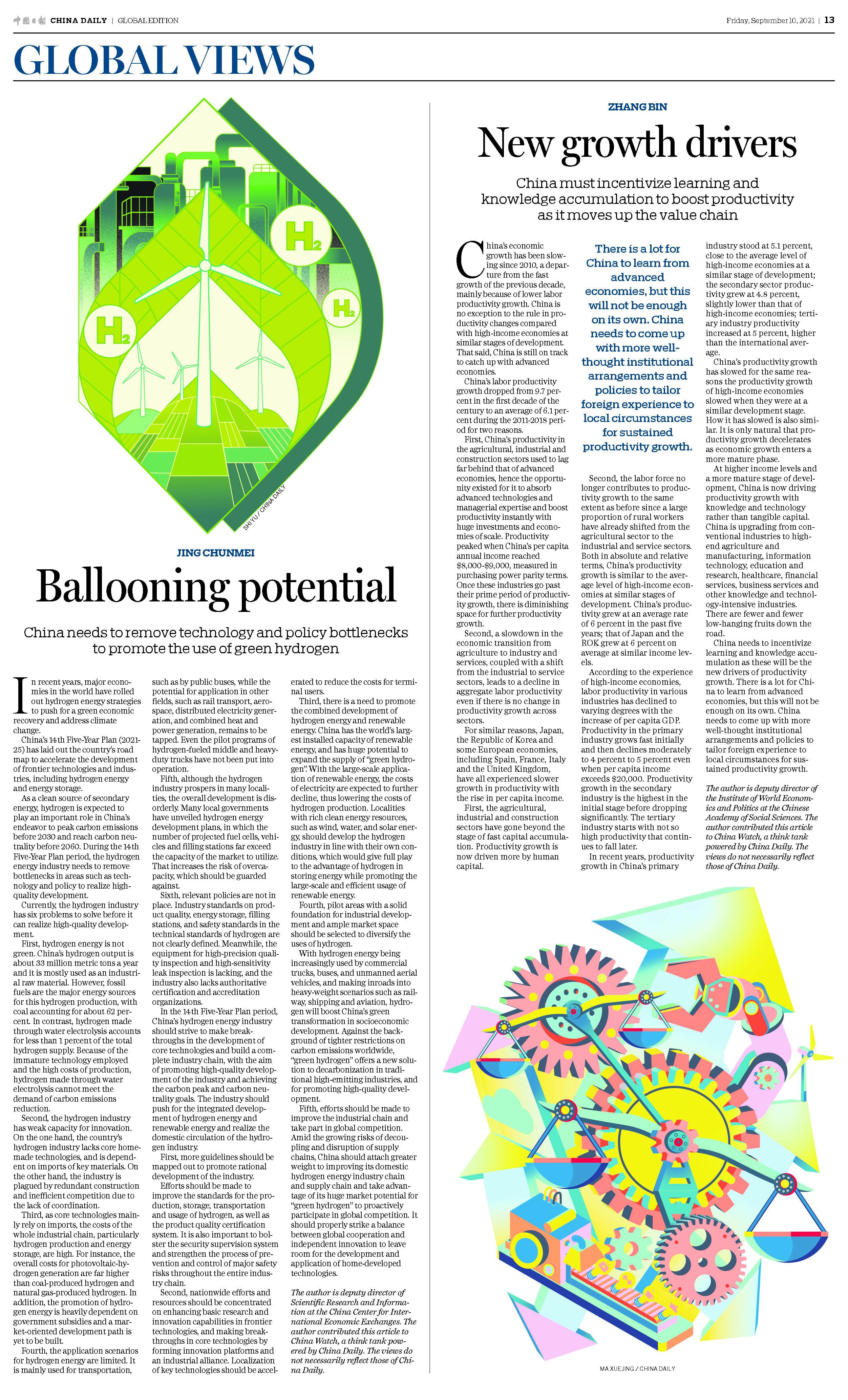Jing Chunmei: Ballooning potential
- Time:2021-09-13
- source:中国国际经济交流中心
By China Daily Global | Updated: 2021-09-10
Jing Chunmei, Deputy Head, Department of Research Management and Information Services (Institute of Energy Policy Studies) of CCIEE
In recent years, major economies in the world have rolled out hydrogen energy strategies to push for a green economic recovery and address climate change.
China's 14th Five-Year Plan (2021-25) has laid out the country's road map to accelerate the development of frontier technologies and industries, including hydrogen energy and energy storage.
As a clean source of secondary energy, hydrogen is expected to play an important role in China's endeavor to peak carbon emissions before 2030 and reach carbon neutrality before 2060. During the 14th Five-Year Plan period, the hydrogen energy industry needs to remove bottlenecks in areas such as technology and policy to realize high-quality development.
Currently, the hydrogen industry has six problems to solve before it can realize high-quality development.
First, hydrogen energy is not green. China's hydrogen output is about 33 million metric tons a year and it is mostly used as an industrial raw material. However, fossil fuels are the major energy sources for this hydrogen production, with coal accounting for about 62 percent. In contrast, hydrogen made through water electrolysis accounts for less than 1 percent of the total hydrogen supply. Because of the immature technology employed and the high costs of production, hydrogen made through water electrolysis cannot meet the demand of carbon emissions reduction.
Second, the hydrogen industry has weak capacity for innovation. On the one hand, the country's hydrogen industry lacks core homemade technologies, and is dependent on imports of key materials. On the other hand, the industry is plagued by redundant construction and inefficient competition due to the lack of coordination.
Third, as core technologies mainly rely on imports, the costs of the whole industrial chain, particularly hydrogen production and energy storage, are high. For instance, the overall costs for photovoltaic-hydrogen generation are far higher than coal-produced hydrogen and natural gas-produced hydrogen. In addition, the promotion of hydrogen energy is heavily dependent on government subsidies and a market-oriented development path is yet to be built.
Fourth, the application scenarios for hydrogen energy are limited. It is mainly used for transportation, such as by public buses, while the potential for application in other fields, such as rail transport, aerospace, distributed electricity generation, and combined heat and power generation, remains to be tapped. Even the pilot programs of hydrogen-fueled middle and heavy-duty trucks have not been put into operation.
Fifth, although the hydrogen industry prospers in many localities, the overall development is disorderly. Many local governments have unveiled hydrogen energy development plans, in which the number of projected fuel cells, vehicles and filling stations far exceed the capacity of the market to utilize. That increases the risk of overcapacity, which should be guarded against.
Sixth, relevant policies are not in place. Industry standards on product quality, energy storage, filling stations, and safety standards in the technical standards of hydrogen are not clearly defined. Meanwhile, the equipment for high-precision quality inspection and high-sensitivity leak inspection is lacking, and the industry also lacks authoritative certification and accreditation organizations.
In the 14th Five-Year Plan period, China's hydrogen energy industry should strive to make breakthroughs in the development of core technologies and build a complete industry chain, with the aim of promoting high-quality development of the industry and achieving the carbon peak and carbon neutrality goals. The industry should push for the integrated development of hydrogen energy and renewable energy and realize the domestic circulation of the hydrogen industry.
First, more guidelines should be mapped out to promote rational development of the industry.
Efforts should be made to improve the standards for the production, storage, transportation and usage of hydrogen, as well as the product quality certification system. It is also important to bolster the security supervision system and strengthen the process of prevention and control of major safety risks throughout the entire industry chain.
Second, nationwide efforts and resources should be concentrated on enhancing basic research and innovation capabilities in frontier technologies, and making breakthroughs in core technologies by forming innovation platforms and an industrial alliance. Localization of key technologies should be accelerated to reduce the costs for terminal users.
Third, there is a need to promote the combined development of hydrogen energy and renewable energy. China has the world's largest installed capacity of renewable energy, and has huge potential to expand the supply of "green hydrogen". With the large-scale application of renewable energy, the costs of electricity are expected to further decline, thus lowering the costs of hydrogen production. Localities with rich clean energy resources, such as wind, water, and solar energy, should develop the hydrogen industry in line with their own conditions, which would give full play to the advantage of hydrogen in storing energy while promoting the large-scale and efficient usage of renewable energy.
Fourth, pilot areas with a solid foundation for industrial development and ample market space should be selected to diversify the uses of hydrogen.
With hydrogen energy being increasingly used by commercial trucks, buses, and unmanned aerial vehicles, and making inroads into heavy-weight scenarios such as railway, shipping and aviation, hydrogen will boost China's green transformation in socioeconomic development. Against the background of tighter restrictions on carbon emissions worldwide, "green hydrogen" offers a new solution to decarbonization in traditional high-emitting industries, and for promoting high-quality development.
Fifth, efforts should be made to improve the industrial chain and take part in global competition. Amid the growing risks of decoupling and disruption of supply chains, China should attach greater weight to improving its domestic hydrogen energy industry chain and supply chain and take advantage of its huge market potential for "green hydrogen" to proactively participate in global competition. It should properly strike a balance between global cooperation and independent innovation to leave room for the development and application of home-developed technologies.

